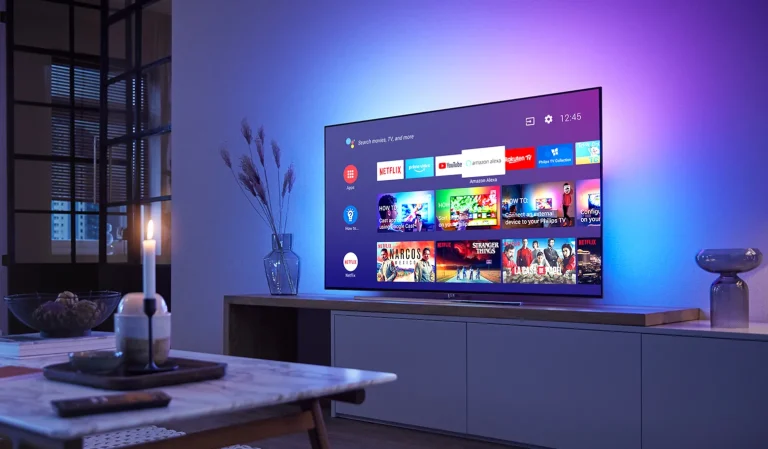How to Wall Mount a Hisense 75 Inch TV – Easy Guide
Last Updated on November 1, 2023 by Jhonni Jets

Wall mounting a large, 75 inch TV like the Hisense can seem intimidating, but it’s actually a straightforward process if you follow some simple steps. Properly mounting your TV on the wall provides a cleaner, more streamlined look while also keeping your TV secure and reducing the risk of accidents or damage.
In this comprehensive guide, we’ll walk you through everything you need to know to safely and successfully wall mount your Hisense 75 inch television, from choosing the right mounting equipment to installing it properly on your wall. With a little bit of planning and the right tools, you can mount your TV in no time!
Table of Content
Step 1: Choose the Right Mount
The most important part of wall mounting any TV is selecting the proper mounting equipment to securely hold the display on your wall. Here are the key factors to consider when picking out a wall mount for your 75” Hisense TV:
- Weight capacity: Check the specs of your Hisense TV and choose a mount rated to hold at least that much weight. The TV likely weighs between 55-70 lbs, so a mount rated for 75-100 lbs should be sufficient.
- VESA compatibility: Your TV will have a standardized VESA mounting pattern on the backside that you need to match up to the mount. For a 75” Hisense, this is likely a 400x400mm or 400x600mm pattern.
- Mounting location: Determine if you want your mount fixed in one position or an articulating arm mount that allows you to angle/swivel the TV. Fixed mounts are simpler while articulating mounts offer more flexibility.
- Features: Look for a mount with built-in cable management channels, spacers to accommodate uneven walls, and locking mechanisms for added security. Low-profile mounts hug the wall tightly.
- Budget: Prices range from $30 up to $150+ for high-end mounts. For a 75” TV, expect to spend $70-100 for a sturdy, secure mount.
Once you know your VESA pattern, weight capacity, and design preferences, you can zero in on the ideal wall mount model for your Hisense television. Reputable brands like Sanus and Perlesmith make quality mounts.
Step 2: Gather Your Tools
Installing a TV wall mount is largely about precise measuring and drilling. Gather the following tools before getting started:
- Stud finder – An electronic stud finder will detect wood studs behind your drywall for securing the mount screws.
- Level – A bubble level will help ensure your mount is even and properly angled.
- Drill and drill bits – A power drill with the appropriate drill bits for pilot holes and screw holes. Phillips and socket driver bit heads.
- Screws – Wall lag screws for securing your mount in wood studs. The size and type vary based on your mount and stud depth.
- Wrench – For bolting your TV onto the mount plate. A ratcheting wrench is helpful.
- HDMI cables – To connect devices to your mounted TV. Opt for slim, low-profile cables.
- Helper – Having an extra pair of hands makes positioning and installing much easier. A friend or relative can assist.
Gather all equipment ahead of time so you’re not missing anything once you get started on the actual wall mounting process. Safety gear like glasses and gloves is also a good idea when drilling and handling a large television.
Step 3: Determine Mounting Location
Now it’s time to determine the optimal spot to mount your Hisense television on the wall. Here are the key factors to consider:
- Viewing angles – The TV should be positioned so it’s easy to see when viewing from seating areas like your couch. Avoid mounts that make viewing uncomfortable.
- Height – Mounting the TV too high will make your neck sore. About 42 inches from the floor to the center of the screen is ideal. You can go lower if desired.
- Furniture – Ensure there’s nothing like shelves or cabinets directly below the mounted TV that will obstruct it. Leave ample clearance.
- Cable access – Leave room to route power cords, antenna cables, and HDMI cords behind the TV without excessive strain. Islands can help hide cables.
- Lighting – Avoid light sources like windows directly opposite the television, which creates glare on the screen. Ambient room lighting should be relatively soft.
Use a tape measure to map out exactly where you’ll install the mount on your wall. Remember it’s easier to adjust left/right positioning than height after the mount is up. Mark your stud center locations with pencil.
Step 4: Install Wall Mount
Now for the fun part – it’s time to actually mount your TV bracket on the wall. Follow these steps:
- Locate your wood studs using the stud finder and mark the centers with pencil. Studs are usually 16 inches apart.
- Hold the mount at your desired height and mark the bracket holes. Make sure at least 2-3 holes line up over studs – they must attach directly to studs.
- Drill pilot holes at your stud marks for each lag screw. Pilot holes should be slightly narrower than screw diameter.
- Hold the mount in place and drill lag screws into the pilot holes to firmly secure the mount. Don’t tighten all the way yet in case adjustments are needed.
- Check level and use included spacers/shims if the mount is not flush with the wall. Tighten all lag screws securely once properly leveled.
- Drill any remaining drywall anchors for non-stud locations per the mounting instructions. Make sure the mount is stable.
If using an articulating mount with arms, attach them to the plate bracket at this point before proceeding. Your sturdy wall mount is now fully installed and ready for the TV!
Step 5: Lift TV onto Mount
Here comes the challenging part – safely lifting your large, bulky TV up onto the mounted bracket. Here are some tips:
- Leave the TV in its packaging styrofoam for moving it. This minimizes handling the TV itself.
- Bring the boxed TV as close as possible to the final mounting location before unpacking.
- Unbox the TV top-side up right below the mounted bracket.
- Have at least two strong people perform the lift, with one person on each side.
- Lift with legs, not back. Keep the TV vertically level as you lift and avoid twisting.
- Place one corner’s VESA holes over the mount screws, then tilt up to align the remaining holes.
- Attach washers and bolts through the VESA holes into the mount plate to secure in place
- Make cable connections before releasing your grip so the TV doesn’t fall prematurely.
Take it slowly and get help lifting something as heavy and fragile as a 75 inch TV. Preventing injury or damage should be the top priority during this challenging step.
Step 6: Manage Cables
Once your TV is securely mounted, the last step is neatly organizing all the cables so they are out of sight as much as possible. Here’s how:
- Group similar cables like HDMI or speaker wires to keep them organized.
- For cables going straight down, bundle them together and use velcro straps regularly.
- Wrap cables behind arms/brackets of articulating mounts to keep tidy.
- Use wire covers or channels along the wall and corners to contain cables going horizontally.
- Mounted cable boxes or consoles can go on nearby shelves to reduce dangling wires.
- Avoid bending cables at sharp angles that could wear them out over time.
Properly managing cables maintains your clean mounted look and minimizes tripping hazards. For power cords, use extensions to route down from above outlets whenever possible.
Conclusion
While wall mounting a 75 inch television seems intimidating, it simply involves careful planning, high-quality equipment, and taking your time at each step. Now you can enjoy your Hisense TV in a brand new, streamlined way while also keeping it secure. Enjoy your crisp picture quality without the clutter of a bulky base or stand.
Here are a few final tips for success:
- Have a helper provide an extra set of hands during the install
- Triple check your measurements and mount locations before drilling
- Be careful not to drop the TV or accidentally knock it over mid-mount
- Use cable management solutions to contain and conceal wires
- Check all connections to ensure your devices work with the mounted setup
Follow this guide, take the process step-by-step, and soon you’ll have a beautiful, wall mounted Hisense TV perfectly positioned for enjoyable viewing in your space. Enjoy the sleek new look!







